Derby's Heritage Part 32 - The Silk Mill Museum
w/e 26 August 2012
All this week's pictures were taken
with a Kodak DX6490
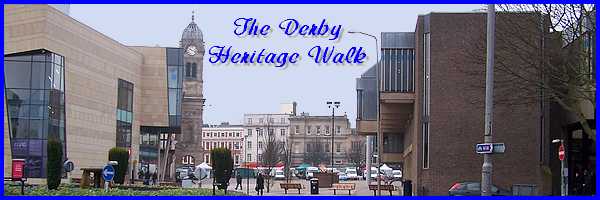
WARNING: In April 2011, the Silk Mill Museum closed
its doors to the public and it was mothballed "for two years"
as part of a cost cutting exercise in a difficult economic climate.
At the time of writing the museum is still closed so I would
advise anyone contemplating a visit to the Silk Mill to contact
Derby
City Council to ascertain the current
situation. Telephone: 01332 641901
 Although
not currently open we visited the museum towards the end of March
2011 just days before it closed which is when all of the images
below were captured. I was aware then that our route around the
city would eventually reach the Silk Mill but was not sure when
that would be or whether it would be open again. It would be
a travesty for a project such as this Derby Heritage Walk to
omit the museum altogether as within its walls much of the industrial
heritage is encapsulated. So I make no apology for including
the pictures here although they only give a glimpse inside and
a little flavour of Derby's industrial history. The museum is
well worth a visit but please take heed of the above warning
and check before visiting. Although
not currently open we visited the museum towards the end of March
2011 just days before it closed which is when all of the images
below were captured. I was aware then that our route around the
city would eventually reach the Silk Mill but was not sure when
that would be or whether it would be open again. It would be
a travesty for a project such as this Derby Heritage Walk to
omit the museum altogether as within its walls much of the industrial
heritage is encapsulated. So I make no apology for including
the pictures here although they only give a glimpse inside and
a little flavour of Derby's industrial history. The museum is
well worth a visit but please take heed of the above warning
and check before visiting.
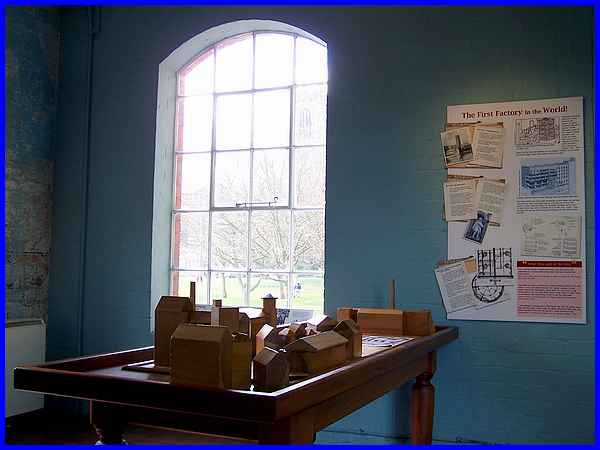
On entering the museum we were directed up to the first floor
to begin the tour and were greeted by a table filled with wooden
blocks which could be assembled in order to show the development
of the different phases of the Silk Mill complex. As the wall
display behind shows the Silk Mill was the world's first factory.
It now stands at the southern end and is part of the Derwent
Valley Mills World Heritage Site.
|
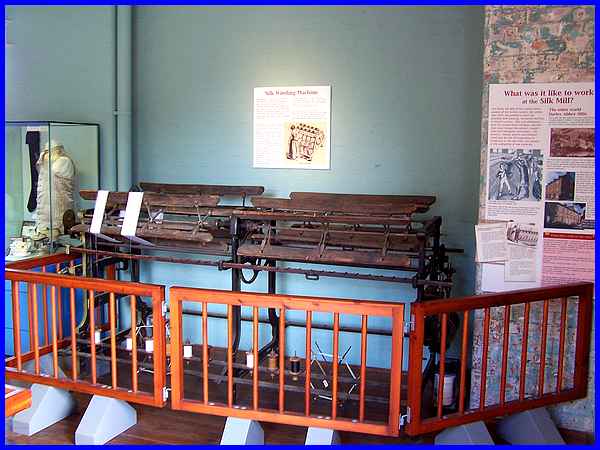
The museum is very much a "hands on" experience but
some exhibits are protected in glass cabinets and others like
this historic silk winding machine protected by a simple barrier.
|
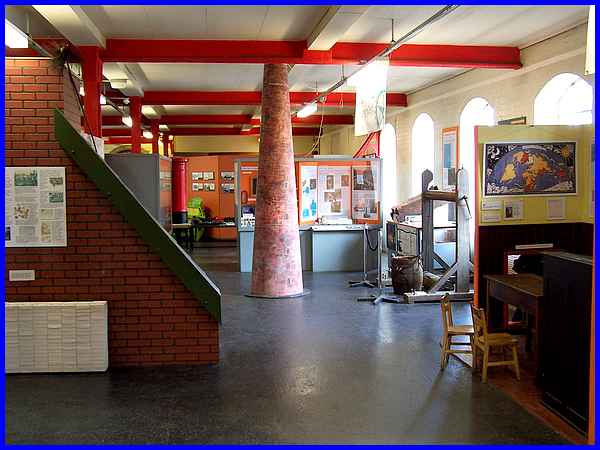
We found the museum to be interesting, educational and entertaining
with many interactive features on the first floor aimed at younger
visitors but still very informative for older generations too.
Among the displays are a mock up of a Victorian pharmacy and
also of a framework knitters cottage (see left of image above).
|
Derby of course grew as a railway town and a large
section of the first floor is devoted to that industry.
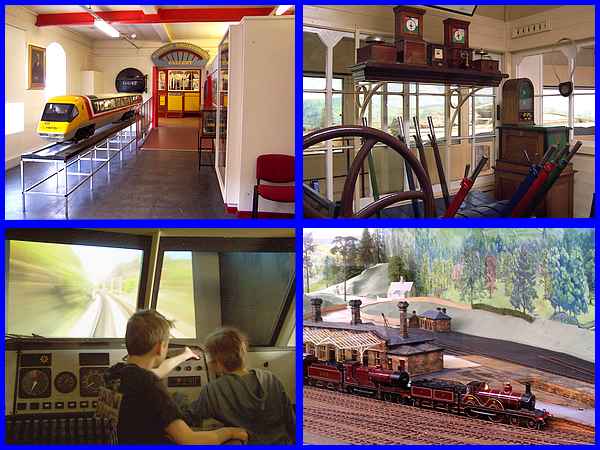
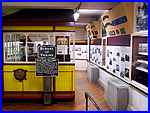 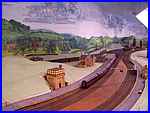 A large model of a modern InterCity train
leads into the Railway Engineering Gallery where levers can be
pulled in a signal box that overlooks the ultimate big boys'
toy, a working scale model railway layout. Another part of the
Gallery includes the cab of a modern train where young drivers
can experience the thrill of driving a high speed engine courtesy
of a video playing in front of the controls. A large model of a modern InterCity train
leads into the Railway Engineering Gallery where levers can be
pulled in a signal box that overlooks the ultimate big boys'
toy, a working scale model railway layout. Another part of the
Gallery includes the cab of a modern train where young drivers
can experience the thrill of driving a high speed engine courtesy
of a video playing in front of the controls.
|
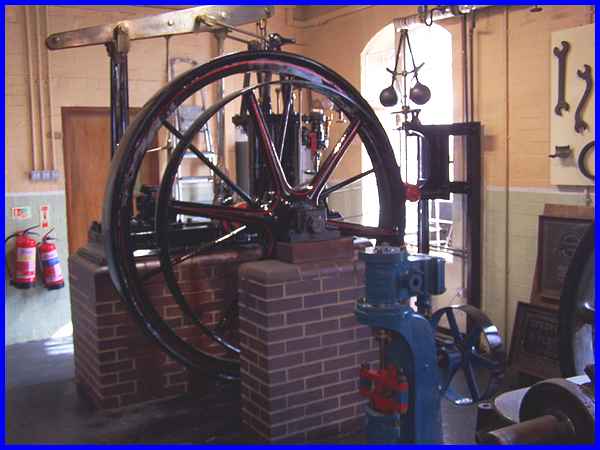
We made our way down to the ground floor where one section is
devoted to engines using various power sources showing their
development over the years from wind, steam and gas through to
electricity. The Grasshopper beam engine (pictured) was built
about 1850 by George Fletcher, a Derby born engineer who used
it to power machinery in his London workshop. It was moved later
(1863) to his new Masson works in Litchurch Lane, Derby where
it operated there until 1911. The engine has been a feature of
the museum since 1975 and was restored to steam power in 1993/4.
|
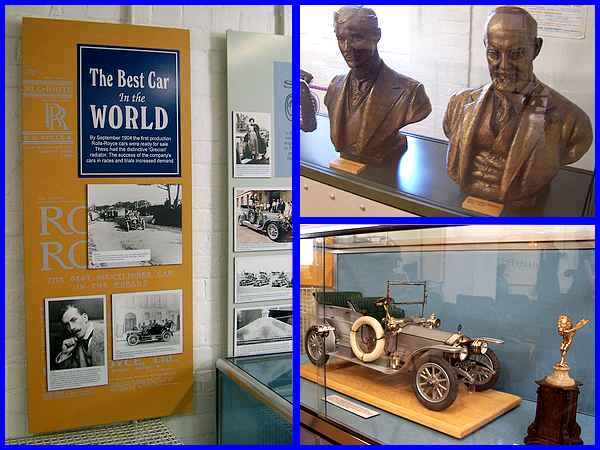
As well as railways of course Derby is also famous for being
the home of "The Best Car in the World" and a display
containing a model of an early design of that said car is accompanied
by busts of the Hon. Charles Stewart Rolls and Sir Frederick
Henry Royce, co-founders of Rolls-Royce.
|
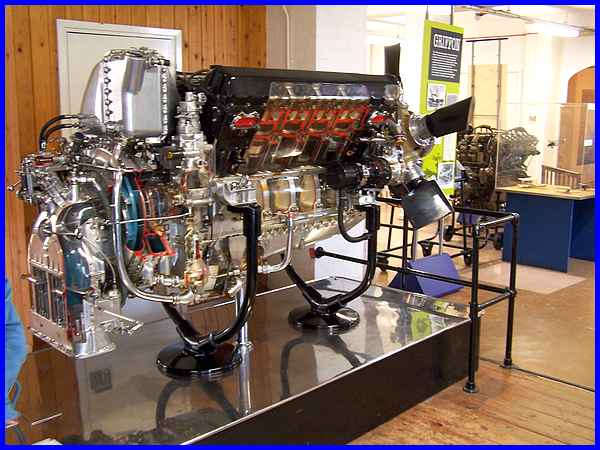
Rolls-Royce forms a major part of the ground floor area and one
of the engines on display is the famous Griffon which was named
after the bird of prey, the Griffon Vulture. The liquid-cooled
aero engine was designed and built by Rolls-Royce at the request
of the Fleet Air Arm in 1938 and was adapted a year later for
use in the Spitfire aircraft, going into production in the 1940s.
Although production ceased in 1955, the Griffon engines are still
in use today in restored Firefly and Spitfire aircraft and in
the Royal Air Force service with the Battle of Britain Memorial
Flight among others.
|
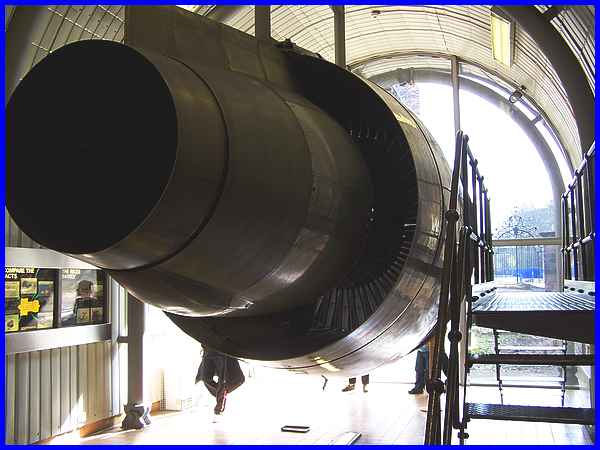
 Perhaps the pièce
de résistance in the museum though is the Rolls-Royce
RB211 where a high level platform allows visitors to get up close
and personal with the engine. Development of the gas turbine
engine almost brought about the bankruptcy of Rolls-Royce but
nationalisation by the government allowed work on the engine
to be completed and the company became a major commercial player
on a global scale supplying engines to many of the world's airlines.
Further development led to the Trent family of engines and the
RB211 was superseded in the 1990s but this example in the Silk
Mill museum is still an impressive piece of work. Perhaps the pièce
de résistance in the museum though is the Rolls-Royce
RB211 where a high level platform allows visitors to get up close
and personal with the engine. Development of the gas turbine
engine almost brought about the bankruptcy of Rolls-Royce but
nationalisation by the government allowed work on the engine
to be completed and the company became a major commercial player
on a global scale supplying engines to many of the world's airlines.
Further development led to the Trent family of engines and the
RB211 was superseded in the 1990s but this example in the Silk
Mill museum is still an impressive piece of work.
There are many more engines on the ground floor of the Silk Mill
and a whole website could easily be devoted to the Museum but
in the next part of the Derby Heritage Walk, we'll continue along
the River Derwent by the side of the Silk Mill.
|

